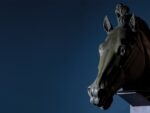Rudolf Steiner – Ricochet
.jpg)
Con Ricochet, l’artista e fotografo Rudolf Steiner presenta una serie di immagini che documentano la sua attrazione per il misterioso.
Comunicato stampa
Con Ricochet, l'artista e fotografo Rudolf Steiner presenta una serie di immagini che documentano la sua attrazione per il misterioso.
Le fotografie, scattate negli ultimi sei anni nei dintorni del suo studio a Rondchâtel, vicino a Bienne, traducono – grazie all'uso di una speciale tecnica di ripresa digitale – paesaggi di aspre rocce, tunnel abbandonati e grandi impianti industriali in "tableaux" di strana bellezza.
Il termine Ricochet deriva dal francese e significa "rimbalzo" o "contraccolpo" ed è spesso usato in connessione con armi da fuoco o artiglieria. Con questa parola, Steiner si riferisce a una teoria della visione di Platone, che afferma che un "raggio di visione" emana dall'occhio in movimento e scansiona il mondo nel campo visivo - come un cieco con il suo bastone che scansiona la strada di fronte a lui, o come uno scanner che registra il visibile riga per riga per emetterlo come immagine.
A causa della lunga durata della sessione di registrazione, le influenze atmosferiche come il vento, i cambiamenti di luce dovuti alle nuvole e alla nebbia sono inscritti nell'immagine - il "raggio visivo" rimbalza, i "ricochet" vengono registrati.
With Ricochet, the artist and photographer Rudolf Steiner presents a series of pictures that document his fascination for the uncanny.
The photos, taken over the last six years in the surroundings of his studio in Rondchâtel near Biel, translate –thanks to the use of a special digital shooting technique– the landscapes of rugged rocks, abandoned tunnels and huge industrial plants into "tableaux" of strange beauty.
The word Ricochet comes from French and means "rebound" or "bounce back" and is often used in connection with firearms or artillery. With this term, Steiner refers to a theory of perception by Plato, which states that a "ray of vision" emanates from the moving eye and scans the world in the field of vision - like a blind man with his blind cane scanning the street in front of him, or like a scanner registering the visible line by line in order to output it as an image.
Due to the long duration of the recording session, atmospheric influences such as wind, light changes due to clouds and fog are inscribed into the picture - the "visual ray" bounces off, the "ricochets" are recorded.



